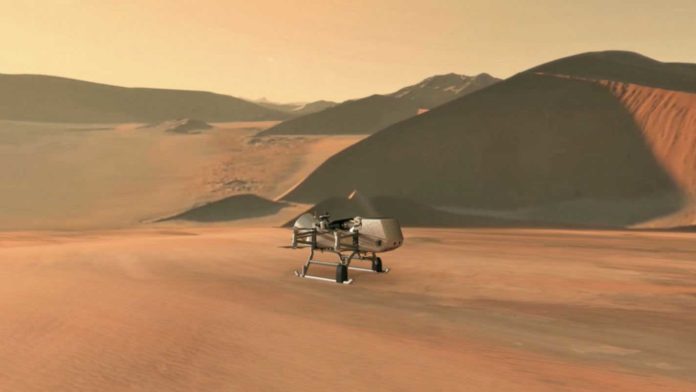NASA has announced its next destination in the solar system- Saturn’s largest moon Titan. In the search for signs of life, NASA will send a multi-rotor vehicle called ‘Dragonfly’ to explore the richly organic world.
Dragonfly is a Mars rover-sized drone that will be able to fly from place to place on Titan. Equipped with instruments capable of identifying large organic molecules, is slated to launch in 2026, arrive at its destination in 2034 and then fly to multiple locations hundreds of miles apart.
The 10-foot-long and the 10-foot-wide dual quadcopter will resemble a giant drone, with eight rotors helping it take off over the moon’s surface for about 8 or 9 miles (12-14 kilometers) within an hour. It will make one of these hops about once every 16 days, investigating future landing sites, spending much time inspecting the surface and observing the weather. It will likewise have the option to make shorter hops of only a couple of feet if the scientists spot something fascinating near to the landing site.
NASA Administrator Jim Bridenstine said, “With the Dragonfly mission, NASA will once again do what no one else can do. Visiting this mysterious ocean world could revolutionize what we know about life in the universe. This cutting-edge mission would have been unthinkable even just a few years ago, but we’re now ready for Dragonfly’s amazing flight.”

Titan is larger than the planet Mercury and as geographically diverse as Earth. This large, cold moon features a thick, methane-rich atmosphere, mountains of ice and the main surface seas in a solar system close to those on Earth. Be that as it may, on Titan, the rivers and lakes are full of sloshing liquid hydrocarbons. If the moon harbors water, scientists believe it exists in an underground ocean lurking beneath the frozen crust.
Thomas Zurbuchen, NASA’s associate administrator for Science at the agency’s Headquarters in Washington said, “Titan is unlike any other place in the solar system, and Dragonfly is like no other mission. It’s remarkable to think of this rotorcraft flying miles and miles across the organic sand of Saturn’s largest moon, exploring the processes that shape this extraordinary environment. Dragonfly will visit a world filled with a wide variety of organic compounds, which are the building blocks of life and could teach us about the origin of life itself.”
Dragonfly was selected as part of the agency’s New Frontiers program, which includes the New Horizons mission to Pluto and the Kuiper Belt, Juno to Jupiter, and OSIRIS-REx to the asteroid Bennu. Dragonfly is led by Principal Investigator Elizabeth Turtle, who is based at Johns Hopkins University’s Applied Physics Laboratory in Laurel, Maryland.
New Frontiers supports missions that have been identified as top solar system exploration priorities by the planetary community. The program is managed by the Planetary Missions Program Office at NASA’s Marshall Space Flight Center in Huntsville, Alabama, for the agency’s Planetary Science Division in Washington.
Lori Glaze, director of NASA’s Planetary Science Division said, “The New Frontiers program has transformed our understanding of the solar system, uncovering the inner structure and composition of Jupiter’s turbulent atmosphere, discovering the icy secrets of Pluto’s landscape, revealing mysterious objects in the Kuiper belt, and exploring a near-Earth asteroid for the building blocks of life. Now we can add Titan to the list of mysterious worlds NASA will explore.”
